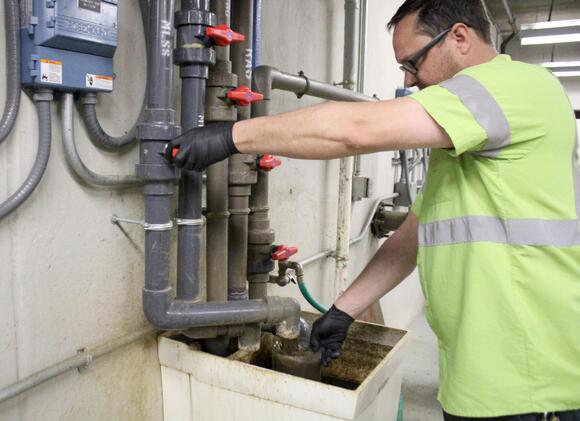
Wastewater treatment works like the human gut, Jordan Plotz explained.
Plotz is the lead operator of the Lonsdale Wastewater Treatment Plant, where the increasing number of drains in Lonsdale eventually lead. He and Public Works Director Joe Dornfeld recently began a bioaugmentation program at the facility, which they hope will increase efficiency, reduce operational cost and slow the need for expansion.
“Basically, it’s a bunch of freezer-dried spores of bacteria that are specifically designed to treat the wastewater, to treat the BOD (Biochemical Oxygen Demand) and solids and helps just to keep the population for food-to-mass balance in check,” he said. “… With the higher flows and the population going up, we’ve seen an increase in the amount of food coming in and there’s not enough bugs to consume it.”
The facility has seen a sizable increase in water coming in, due to Lonsdale’s continued population increases in recent years. To prevent from needing to expand operations, Plotz recommended a bioaugmentation program, which was approved by the Lonsdale City Council in late February.
“By adding these bugs, we can reduce fats, oils and grease,” Dornfeld told the council. “We can improve cold-weather operation at the Wastewater Treatment Plant. We will maintain a healthy environment and biology in the plant. And we will increase settling, which in turn will reduce hauling cost.”
When wastewater arrives at the facility, it begins in a reclamation building, where large materials are filtered out. This is where the tampons, condoms, wipes and other wrongly flushed solids are removed.
“You can always tell when it’s corn season in here,” Plotz joked.
The water then travels through three mixed pools before going into an aerated pond, which consumes a significant amount of energy during operation. The aeration helps support the microbial population that helps to separate the waste from the water.
Water from that pond then travels into the giant domes seen outside the facility. First, it goes into the digester, which works like a human digestive system and is where more bugs eat away at the solids in the water.
The water then goes into the clarifier, where it goes through another cleaning phase that includes chlorinating the water to kill the filamentous bacteria, which prevent the good bacteria from eating. Clear water and brown sludge are the two byproducts of the entire process.
The clear water goes into Union Lake. The brown sludge is hauled to local farmlands, where it is used like fertilizer or manure. Farmers are able to use this product for free.
At one point during past operations, the last public works director decided to shut down one of the two ponds at the facility to help reduce operational costs. Dornfeld said this brought their 687,000-gallons-per-day facility down to about 200,000 gallons per day actually being treated.
Now, they’re treating around 330,000-360,000 gallons per day, meaning they’ll need to add the second pond soon. This would significantly increase operational costs, so the bioaugmentation is intended to slow down that transition.
Plotz got the idea from Pelican Rapids, where he used to work. They recently started a similar program, which he said was successful. So, he gave it a shot.
While it hasn’t been long enough to officially see results, Plotz said he’s anecdotally seen increased settling of the solids. In other words, the bacteria seem to be doing their jobs.
“We’re hoping to see a reduction in the amount of sludge we haul out, by having more bugs eating at this and feeding them on a continual basis,” Plotz said. “We plan to see maybe a 30% reduction in hauling cost, of how much sludge we have to haul, because they charge us by, say, the gallon. And, so, the less gallons of sludge we haul out, the more we save.”
 Most Popular
Most Popular

Comments / 0